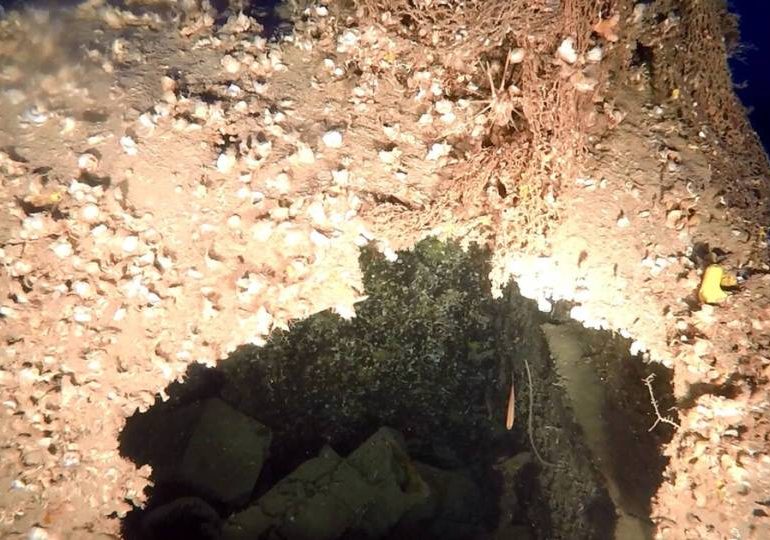THE battered remains of one of the most tragic shipwrecks in Greek history have finally been recovered nearly 80 years after it first sunk.
The infamous minesweeper known as Sperchios had 136 people on board the great ship when tragedy struck in 1945 as it failed to navigate around a World War Two minefield and ultimately capsized.
YouTubeTHE battered remains of one of the most tragic shipwrecks in Greek history have finally been recovered[/caption]
YouTubeThe infamous minesweeper known as Sperchios hasn’t been seen since it capsized nearly 80 years ago[/caption]
YouTubeIt has stayed in pretty good condition and is now even a home to the nearby fishes[/caption]
At least 98 people died in the freezing conditions out at sea after the ship quickly swelled with water and plunged into the depths of the sea.
A clever underwater research mission was deployed when the Sperchios was located five nautical miles off the Greek island of Hydra.
Head researcher Kostas Thoktaridis told APE-MPE: “The wreck is located on the seabed bearing two degrees port and at a depth of 153 meters northeast of Hydra in international territorial waters.
“In the bow can be seen the 20mm gun mount that the ship carried before its conversion from minesweeper to auxiliary fleet.”
Amazing footage of the rescue shows the vessel overgrown with rusticles on its sides after sitting abandoned for 79 years.
The ship crashed into the seabed on its side where it still sits today just off Akra Zourva, Hydra.
Clips show the wreckage, void of any humans for deacdes, has become loving home for sea life as fish can be seen flowing in and out of the ship’s rusting walls.
Much of the main structure is still intact including the giant bow.
Thoktaridis only found a few small issues with the sinking ship as the left anchor chain was absent and a tiny crack was found on the side.
The footage was taken from an ROV unmanned underwater vehicle that was able to scan the wreckage and bring back the crucial coordinates so it could be resurfaced at a later date.
It was first spotted through sonar technology.
A SINKING SHIP
The minesweeper set off on its final journey on May 2, 1945 towards the end of World War Two.
There were 136 people on board the Sperchios when it fatefully started sinking.
Only 38 survived the horror capsizing that was later blamed on overloading.
The Sperchios was reportedly designed to carry just 75 people and when the luggage and cabin goods were all totalled up the ship was constantly leaning to the left on its journey.
This panicked the crew who tried to combat the dodgy swaying by telling passengers to stay on the right of the ship to counter-balance it.
The start of the trip saw beautiful weather and plenty of sunshine so guests happily obliged and stayed on the right hand side out in the open sea air.
But after three-hours the clouds darkened and rain started to fall – pushing everyone inside.
Many of the seating areas inside were towards the middle of the ship or on the left of it meaning as passengers flocked to a chair they ship creaked further and further towards tipping point.
Then, after some navigational miscommunication, the ship’s skipper ran into a dangerous sea minefield.
In an attempt to avoid colliding with one of the lethal explosives he quickly turned the ship.
As the ship turned it became unstable and started to capsize until it started filling up with water and within minutes it was submerged.
Experts have also spent decades hunting for one of the world’s most valuable shipwrecks that could have £1billion in gold onboard.
Dubbed the “El Dorado of the Sea” an English ship named the Merchant Royal sank off the coast of Cornwall leaving behind an incredible amount of riches.
And last year, a never-before-seen 17th century shipwreck was discovered.
The ship carried future Kings of England and was found buried in the sand, untouched for 350 years.
The oldest known wreckage
The world’s oldest shipwreck is the Dokos shipwreck, which dates back to the second Proto-Helladic period, 2700–2200 BC.
That puts it at around 4,224 years old, making it the oldest underwater shipwreck discovery known to archaeologists.
Located off the coast of southern Greece near the island of Dokos in the Aegean Sea, the wreck sits about 50-100ft beneath the surface.
The discovery was made by American archeologist Peter Throckmorton on August 23, 1975.
However, with everything on board that was biodegradable being dissolved by the sea, the ship itself is long gone.
The only surviving evidence of the shipwreck is a cargo site of hundreds of clay vases and other ceramic items that were carried aboard the ship.
According to the Hellenic Institute of Marine Archaeology (HIMA), the pottery consisted of hundreds of ceramic pieces including cups, kitchenware, and urns.
Over 500 clay vases were uncovered, dating to the Early Helladic period, and there were a variety of sauceboats in multiple shapes and sizes.
These artefacts and items were raised from the sea floor and transported to the Spetses Museum, where they have been placed into conservation.
YouTubeThe ship sank as it tried to avoid a sea minefield in 1945[/caption]
Leave a comment







